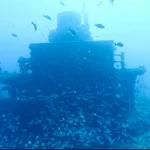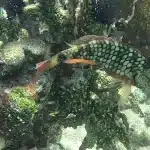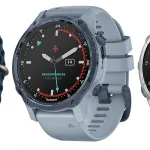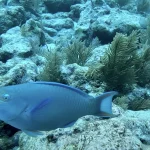Understanding the Night Reef Ecosystem
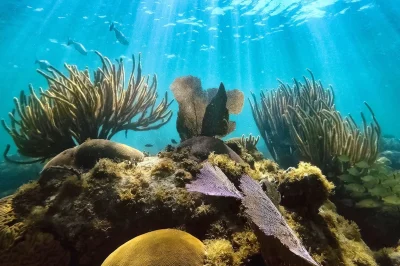
Table of Contents
- Understanding the Night Reef Ecosystem
- Preparation Tips for Night Diving in Key Largo
- Myths About Night Diving, Debunked
- Avoiding Common Mistakes Underwater at Night
- Upcoming Trends in Night Diving Gear
- Key Largo’s Top Night Diving Spots Compared
- Impact of Light Pollution on Nocturnal Marine Behavior
- Predictions for Night Diving’s Role in Conservation
Introduction
Night diving in Key Largo is an exhilarating experience that offers scuba enthusiasts the unique opportunity to witness the dramatic transformation of coral reefs as nocturnal predators come to life. This blog post is designed to guide divers on how to maximise this experience, making the most out of their visit to Key Largo with practical insights, engaging narratives, and well-researched data.
Understanding the Night Reef Ecosystem
Preparation Tips for Night Diving in Key Largo
To prepare effectively for night diving in Key Largo, follow these key strategies:
- Pre-Dive Site Familiarisation
- It is essential to dive the site during daylight first to familiarise yourself with underwater features and spatial relationships. This reduces the risk of disorientation at night and allows for strategic exploration.
- Focus on shallow reefs, common in Key Largo’s bay areas. These locations provide longer bottom times and easier navigation, particularly beneficial when visibility is limited.
- Optimal Dive Timing
- Start your dive at dusk to witness the transition from daylight to darkness. This not only enhances your experience but allows you to observe marine life as they shift between activity cycles.
- Essential Gear & Lighting
- Utilise a reliable primary dive light with a focused beam; it is critical to carry a backup light to ensure safety in case of failure.
- Enhance visibility by attaching a strobe or glow stick to your buoyancy control device (BCD). This makes it easier for dive buddies and boats to locate you in the dark.
- Safety & Communication Protocols
- Check your instruments frequently to monitor your depth and air supply, as visual references are limited in darkness.
- Prior to diving, agree on light-based signals with your buddy. For example, circular motions can signify “OK,” while horizontal lines can indicate alerts.
- Local Recommendations
- Consult local dive shops in Key Largo, such as Horizon Dive Center, for site-specific insights and advice on ideal night diving locations like grass beds and shallow reefs.
Prioritise shallow profiles to enhance your dive experience, and ensure your dive plan includes exit strategies to maintain situational awareness in the dark, ensuring a safe and enjoyable adventure.
Preparation Tips for Night Diving in Key Largo
Common Myths and Realities of Night Diving
Night diving offers a unique experience, but many divers hold misconceptions that can impact their safety and enjoyment. Understanding these myths is essential for a safe and thrilling underwater adventure in Key Largo.
Safety-Related Myths
- Myth: Night diving is inherently more dangerous than daytime diving.
Reality: When proper training, safety protocols, and buddy systems are followed, night diving poses risks comparable to daytime dives.
- Myth: Solo diving is acceptable at night.
Reality: Night dives should always involve a buddy due to reduced visibility and increased difficulty in managing emergencies.
- Myth: Night diving is safe in foul weather or unfamiliar locations.
Reality: Divers should avoid poor weather conditions and unfamiliar sites to minimise risks related to navigational challenges.
Visibility-Related Myths
- Myth: A dive light fully compensates for darkness.
Reality: Dive lights create focal illumination but limit peripheral vision, increasing the risk of visual disorientation.
- Myth: Visibility is as reliable as daylight.
Reality: Night visibility is impacted by limited beam coverage and ambient darkness, making situational awareness challenging.
- Myth: Leaving lights off encourages marine life interaction.
Reality: Divers must keep lights on for safety and to avoid hazards, as darkness without light increases collision risks.
Marine Life Myths
- Myth: Night diving reveals less active or fewer species.
Reality: Many marine species, including nocturnal predators and bioluminescent organisms, are more active at night, offering mesmerising experiences.
- Myth: Night dives lack excitement or variety.
Reality: The underwater environment transforms, providing opportunities to encounter rare species, such as octopuses and squid, and unique ecosystem dynamics.
Key Safety Protocols
- Training & Skills: Master buoyancy control, conduct emergency drills, and get familiar with handling equipment suited for low-light conditions.
- Equipment: Utilise dependable dive lights, backup systems, and visual signals for effective communication with your buddy.
- Pre-Dive Checks: Review weather forecasts, verify dive site conditions, and ensure all participants are sober.
By addressing these myths, divers can approach night diving with the informed preparation needed to fully embrace the allure of the underwater night.
Myths About Night Diving, Debunked
Divers, especially those embarking on night dives, often encounter specific pitfalls that can detract from the experience or even pose safety risks. Understanding these common mistakes is essential for anyone looking to explore the underwater world after the sun sets.
Common Mistakes During Night Dives
- Insufficient Light Sources: Many divers underestimate the importance of having multiple light sources. Relying on a single dive light can be dangerous; if that primary light fails, divers may find themselves in complete darkness. To mitigate this risk, always carry at least two dive lights, which ensures you have a backup in case the primary light fails.
- Poor Signal Communication: Effective communication is crucial, particularly in low visibility conditions. Failing to establish clear light signals before a dive can lead to confusion. Consider using simple light-based signals, such as a circular motion for indicating “OK,” to improve safety and coordination among dive buddies.
- Neglecting Current/Tide Planning: Experienced divers know the importance of checking tide charts and planning dives around slack tide to avoid strong currents. Not doing so can increase the risk of drifting and disorientation. Always account for the environmental conditions before entering the water.
- Overconfidence in Enclosed Spaces: Diving in caves or wrecks requires specialised training. Without proper guidelines or safety measures, the potential for getting lost increases significantly. Ensure you have the appropriate training and equipment when exploring these challenging environments.
- Ignoring Buoyancy/Gear Control: Poor buoyancy control can lead to accidental collisions with marine life or underwater structures, particularly in dark conditions. Familiarity with your gear and practising buoyancy skills can greatly enhance safety during night dives.
- Turning Off Lights Underwater: Another mistake is turning off dive lights during the dive to conserve battery. This can be dangerous if the light fails to turn back on. Always keep your lights switched on and use dimming features to save battery life instead.
- Inadequate Emergency Preparedness: Failing to practise emergency drills for low visibility situations can leave divers unprepared for unexpected scenarios. Conducting practice sessions to familiarise yourself with your gear’s response in dark conditions is essential for building confidence.
By being aware of these common mistakes and taking steps to avoid them, divers can significantly enhance their safety and enjoyment while night diving in Key Largo.
Avoiding Common Mistakes Underwater at Night
Upcoming Trends in Night Diving Gear
As the diving community continually adapts to changing needs and technologies, night diving gear is becoming increasingly sophisticated. Key innovations are aimed at enhancing safety, communication, and visibility during these dynamic underwater excursions.
Enhanced Communication Systems
Underwater communication is critical during night dives, where visibility and group coordination can be particularly challenging. The DIVEVOLK SeaTouch 4 Max offers advanced communication capabilities, enabling clear interaction between divers, even at significant depths. This solution is crucial for maintaining situational awareness during low-light conditions, ensuring that divers remain connected and safe throughout their dive.
Moreover, Aqualung’s Aquasense regulator features integrated sonar communication and a black box recorder, providing real-time navigation and group tracking. This innovative technology significantly reduces risks associated with night diving, allowing divers to navigate more effectively without losing contact with their group.
Smart Dive Computers with AI
Next-generation dive computers are increasingly incorporating AI-powered analytics, which can monitor essential data such as depth, time, and safety protocols in real-time. These advanced models sync with smartphones, offering customisable dive plans and post-dive insights. This capability is particularly valuable during night dives when manual calculations become more complicated due to dim conditions. Maintaining safety is paramount, and these intelligent systems provide divers with peace of mind.
Advanced Lighting Solutions
Although explicit innovations in night-dive lighting gear are still emerging, there is a clear trend towards more sustainable lighting solutions. Expect to see energy-efficient LED systems and eco-friendly battery technologies that improve visibility while reducing environmental impact. Additionally, smartphone housings equipped with optimised underwater lighting will play a role in night diving, enabling divers to capture stunning footage even in low-light situations.
Streamlined Dive Suits
The Aqualung Oceanwings, currently in prototype testing, prioritises streamlined mobility. Designed to minimise drag, this suit could dramatically enhance manoeuvrability during night dives, which is critical when visibility is compromised. Increased mobility helps divers navigate complex underwater landscapes, making night diving experiences more enjoyable and safe.
As divers prepare for exciting adventures in Key Largo, staying informed about these trends will help enhance safety and enjoyment during their nocturnal explorations.
Upcoming Trends in Night Diving Gear
Key Largo Night Dive Hotspots and Marine Life
Key Largo is renowned for its vibrant underwater ecosystems, and night diving here reveals a spectacular transformation of marine life. Below are some popular dive sites, along with insights into marine biodiversity and experience levels required for night dives.
Popular Dive Sites
- Molasses Reef: A shallow coral reef that is ideal for night dives, Molasses Reef is famous for its diverse marine life and frequent sightings of turtles. As night falls, nocturnal species emerge, creating a magical experience for divers. This site caters well to divers looking for both beauty and biodiversity.
- Benwood Wreck: An iconic historic shipwreck located in approximately 60 feet of water, the Benwood attracts larger predators and crustaceans, like lobsters and crabs. Night dives at this site offer a unique opportunity to explore artificial reef ecosystems that thrive around wrecks.
- Elbow Reef & Conch Wall: These sites are popular for their thrilling wall dives and ledge explorations. Dive depths typically range from 18 to 120 feet, making them accessible to a wide range of experience levels.
Marine Biodiversity Highlights
Night diving in Key Largo typically reveals:
- Nocturnal species: Skates, moray eels, octopuses, and a variety of fish species become active at night.
- Crustaceans: Lobsters and crabs are frequently spotted as they emerge from their daytime hiding spots.
- Turtles: Both green turtles and various larger fish may be seen cruising the shallow reefs, contributing to the dynamic night scene.
Experience Levels
Different dive sites cater to varying levels of experience:
- Shallow Reef Dives: Generally suitable for divers with night diving certification, ideal for those with basic experience.
- Wreck Dives (e.g., Benwood): These require moderate to advanced experience, including wreck diving training due to the depth and navigation challenges involved.
Key Statistics
- Depth Variations: Dive sites in Key Largo typically range from 18 to 120 feet, accommodating divers of different skill levels.
- Dive Frequency: Popular sites like Molasses Reef are frequently scheduled by local dive operators, ensuring many opportunities for night diving.
For specific certifications or detailed guidance on site selection, it’s advisable to consult local dive operators like Rainbow Reef Dive Center or Horizon Divers.
Key Largo’s Top Night Diving Spots Compared
During night dives, the effects of light pollution on marine life can be both profound and alarming. The introduction of artificial light into underwater ecosystems substantially alters the behaviour of various marine species, impacting their feeding patterns, reproductive activities, and overall health.
Predator-Prey Dynamics
Artificial lighting at night can increase the prevalence of predatory fish in coral reef environments. This shift in population dynamics may destabilise local ecosystems by intensifying predation pressure on smaller, more vulnerable species. Predatory fish are often drawn to bright areas, leading to unnatural congregation patterns that disrupt typical feeding behaviours among nocturnal marine life.
Feeding Behaviour Disruptions
Light pollution significantly impacts the feeding behaviours of various marine organisms:
- Sea Urchins: Under artificial lights, studies show that sea urchins consume considerably more kelp, leading to overgrazing and ecological imbalance on rocky reefs.
- Zooplankton: These foundational elements of marine food webs are known to migrate deeper to escape artificial illumination, which can impair energy transfer through the ecosystem and lead to discrepancies in the food supply for larger marine animals.
Reproductive and Survival Impacts
Artificial lights also disrupt the reproductive patterns of several species:
- Sea Turtle Hatchlings: These creatures often become disoriented by coastal lighting, which can lead them away from the ocean, increasing mortality rates as they navigate toward inland areas instead.
- Clownfish: Research indicates that clownfish exposed to artificial light experience an alarming 44% reduction in survival rates and display stunted growth, highlighting the heightened risks they face during their early life stages.
Habitat-Seeking and Camouflage Failures
The ability of species to seek out suitable habitats and their camouflage strategies are also undermined by artificial lighting:
- Nesting Behaviour: Female sea turtles are known to avoid nesting on light-polluted beaches to reduce risks to their hatchlings, which rely on natural cues.
- Increased Vulnerability: Artificial light disrupts the natural camouflage of species such as clownfish, enhancing their vulnerability to predators.
Overall, even minimal levels of artificial light can significantly penetrate marine environments, affecting species even at depths previously considered untouched by human activity. The ramifications of light pollution not only compromise individual species but also threaten the health and balance of entire marine ecosystems.
Impact of Light Pollution on Nocturnal Marine Behavior
Night diving uniquely contributes to marine conservation by enabling divers to observe and document the behaviours of nocturnal species in their natural habitats. As many marine creatures, such as octopuses, lobsters, and eels, become active after dark, divers get a rare glimpse into these underwater activities, such as feeding behaviours exhibited by organisms like coral polyps. Observing these patterns helps marine biologists understand the ecological roles these species play, ultimately contributing to conservation efforts by enhancing knowledge about habitat requirements and ecosystem functionality.
To ensure that night diving aligns with conservation goals, divers are encouraged to adopt low-impact exploration techniques:
- Minimal light disturbance: Utilising focused lights helps reduce stress on marine life, allowing for a more natural observation of behaviours.
- Shallow dives: Staying within depths of 15-20 metres minimises energy expenditure for divers, increasing the chance of observing more species without causing excessive disturbances.
- Timed entry: Emerging at dusk helps divers witness the transition from diurnal to nocturnal activities, thereby reducing the likelihood of startling the creatures.
Additionally, shore diving—which is common in regions like Raja Ampat—further lessens the ecological impact by eliminating unnecessary boat traffic, creating a more serene diving experience, and allowing for quicker exit options if needed. This approach supports the local marine environment while minimising potential harm.
Training programmes, such as PADI’s Night Diver course, play a crucial role in fostering environmental stewardship among divers. These courses highlight not only safe diving practices but also the importance of conservation, equipping divers with knowledge that helps promote awareness and respect for marine ecosystems.
As divers prioritise ethical constraints—such as refraining from feeding or touching marine animals—they actively contribute to conservation efforts while experiencing the thrilling spectacle of the underwater world at night. By merging scientific observation with responsible diving practices, night diving serves as a powerful tool for marine conservation, enhancing appreciation for biodiversity and fostering a culture of protection.
Predictions for Night Diving’s Role in Conservation
Marine Life Encounters
Night dives in Key Largo reveal nocturnal creatures like lobsters, shrimp, and bioluminescent organisms. These species emerge from crevices or spawn during darkness, creating an unforgettable underwater experience. The phenomenon of bioluminescence peaks in warmer months, where disturbances in the water trigger glowing reactions from marine life.
Predators such as moray eels, barracudas, and nurse sharks may be more active at night. To avoid attracting predators, refrain from wearing shiny jewellery and always enter the water with a buddy.
Safety Tips
- Plan Your Dive
- Research the dive site’s depth, currents, and hazards as Key Largo’s reefs vary from shallow areas to deep wrecks. Understanding your chosen dive site’s specifics can significantly enhance your diving experience.
- Discuss a dive plan thoroughly with your buddy, including exit strategies and emergency signals.
- Essential Gear
- Dive lights: It is advisable to use a primary light and a backup light. Red lights are preferable as they help preserve night vision.
- Emergency tools: Always carry a dive knife for cutting entanglements, a whistle for signalling, and an additional light in case of failure.
- Health and Limits
- Divers must be physically fit and remain within their certification limits. Avoid diving if you feel fatigued or unwell.
- A vital rule is to never hold your breath; a gradual ascent is critical for safety.
- Buddy System
- Maintain constant visual contact with your buddy and adhere strictly to the rule of “never dive alone.” A buddy can provide assistance during emergencies like equipment failure or disorientation.
Handling Nocturnal Predators
- Avoid Provocation: Stay calm and never feed or touch wildlife.
- Group Diving: Predators are less likely to approach large groups, so dive with others whenever possible.
- Signal Devices: Use a whistle or strobe light to signal for help in an emergency.
Night diving in Key Largo rewards prepared divers with magical encounters but demands strict adherence to safety protocols and local diving practices.
Sources
- PADI – Night Diving Tips
- Scuba Diving – Night Skills
- Captain Hook’s – How to Prepare for Your First Scuba Dive
- Diving Magazine – More than Darkness
- Yucatan Dive Crew – Everything You Need to Know About Night Diving
- Dive Curacao – Scuba Diving Myths
- Divers Alert Network – Night Diving
- Scuba Diving Smiles – Night Scuba Diving Tips

